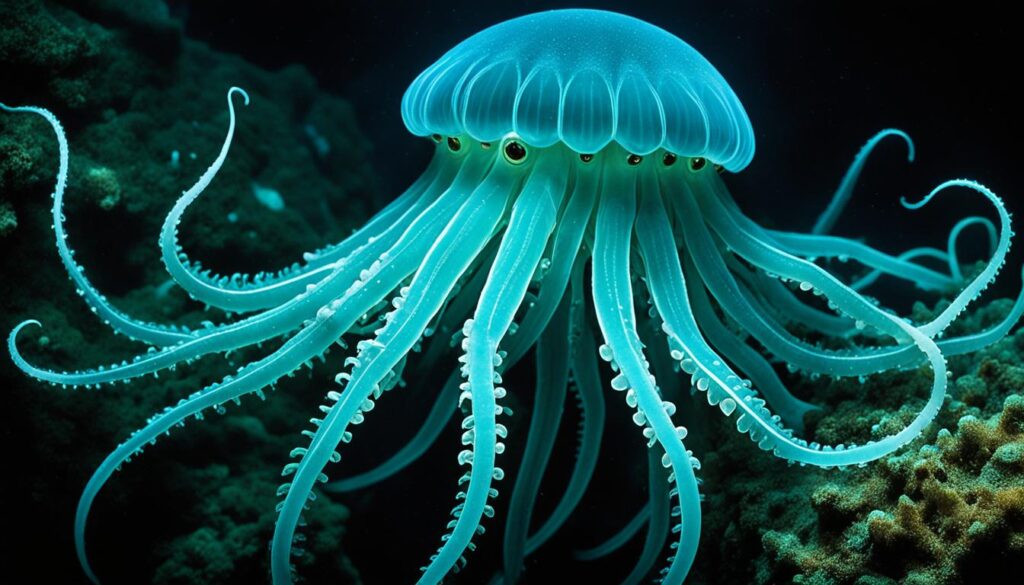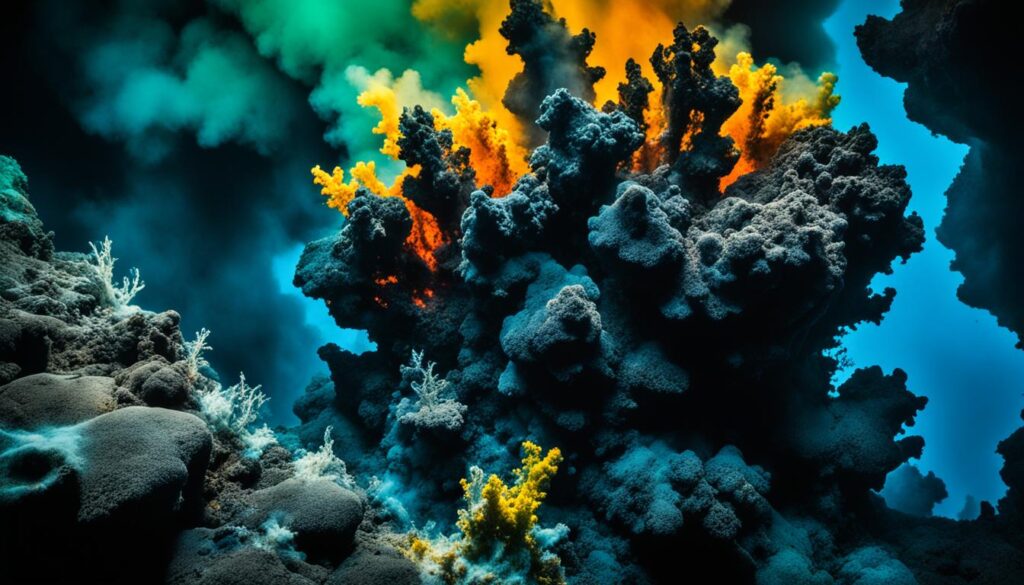Step into the deep sea’s mysterious world, where many creatures live in the dark. They include bioluminescent beings and other unique species. This world is full of life that has adapted to the harsh conditions of the deep sea. Let’s explore the fascinating lives of these ocean mysteries together.
The deep sea stretches far and reaches depths we can barely imagine. Thanks to new technology, we’re learning more about the creatures living there. These beings have amazing ways to survive and adapt to the deep sea’s challenges.
These creatures light up the dark with bioluminescence and play a key role in the deep-sea food web. Scientists and the public find these mysteries fascinating. As we learn more, we realize we must protect their homes from human harm.
This article takes you on a journey to discover deep-sea creatures. You’ll see how they survive and adapt in this tough environment. Get ready to be amazed by the ocean’s hidden wonders.
Exploring the Uncharted Depths
The deep ocean is still a mystery to us. It covers over 60% of our planet and goes down to depths we can hardly imagine. The lowest points are more than 36,000 feet deep. This vast, unexplored sea is a big challenge for scientists.
The Ocean’s Vast Expanses
Getting to the deep ocean is hard. The pressure, lack of sunlight, and extreme temperatures make it tough for humans. For a long time, we knew little about the deep sea. Only a small part of the seabed was explored.
Technological Advancements in Deep-Sea Exploration
Recently, deep-sea exploration has sped up thanks to new technology. Tools like submersibles, ROVs, and AUVs let scientists go deeper. They help us learn about the creatures living in the deep sea. These tools are changing how we study the deep sea, showing us its importance.
Bioluminescent Marvels
Deep-sea creatures can make their own light, a fascinating ability that has caught the eye of scientists and the public. This light-making skill is called bioluminescence. It’s a way for living things to shine on their own. Let’s explore why and how they do this.
The Allure of Glowing Creatures
The deep sea is full of mysteries and wonders. It’s where you’ll find creatures that glow in the dark. These bioluminescent beings light up the deep sea for many reasons, like to talk to each other or to protect themselves. Scientists are keen to learn more about how they do this.
For us, bioluminescent creatures are a sight to behold. Seeing them glow in the dark is magical. It makes us wonder about the ocean’s secrets. By studying these creatures, we learn about their unique ways of surviving in the dark depths.
Animal Adaptations
The deep ocean is tough and unforgiving. It has high pressure, low temperatures, and not much food. But, deep-sea creatures have evolved amazing ways to live in these harsh conditions.
Survival Strategies in Extreme Environments
Deep-sea animals have unique bodies to help them survive. Many have slim, jelly-like bodies to save energy and handle the huge pressure. The anglerfish, for example, has a big, flat head with a glowing lure to catch food in the dark, food-poor waters.
They also have special ways to eat because food is hard to find. The viperfish has huge, needle-like teeth to eat big prey. The deep-sea squid uses its tentacles with suckers and hooks to catch and eat its food.
Deep-sea animals also have ways to use less energy to survive. Many go into a state of torpor, slowing down their bodies to save energy when there’s no food. This amazing trick helps them live in the deep ocean’s tough conditions.

Bizarre and Unique Species
The deep ocean is a world full of strange and unique creatures. These creatures have evolved amazing ways to live in their dark homes. They range from glowing beings to creatures with odd shapes, making the deep sea a fascinating place.
The goblin shark is one of these mysterious creatures. It’s a rare fish with a long jaw and sharp teeth. It’s called a “living fossil” because it looks like an ancient fish. When it catches prey, it quickly opens its jaws.
Another odd fish is the anglerfish. It has a special lure on its head to catch prey. This lure glows, helping the fish to hunt at night. Then, it opens its big mouth to eat its prey.
Some deep-sea fish can even make their own light. Fish like the lanternfish and the flashlight fish glow to talk to each other, find mates, or confuse predators. Scientists are still learning about these glowing fish and how they live.
Every time we explore the deep ocean, we find new and amazing creatures. These creatures are both strange and beautiful. They make us wonder about life on our planet and push us to protect the ocean.
The Deep-Sea Food Web
The deep sea is a complex place where energy and nutrients flow carefully. At its center is the deep-sea food web. This web connects predators and prey, supporting life in the deep ocean.
Predator-Prey Dynamics in the Abyss
In the deep sea’s darkness, creatures have found smart ways to hunt and survive. At the top, giant squid and deep-sea sharks rule. Below them, smaller beings like glowing fish and shrimp-like crustaceans start the food chain.
These creatures show how adaptable life in the deep sea can be. Some, like the anglerfish, use special lures to catch prey. Others glow to attract food or scare off predators. This balance is key to keeping the deep sea’s ecosystem healthy.
Learning about the deep-sea food web is crucial as we explore the ocean. It shows us how these creatures adapt and survive. It also reminds us of the importance of protecting these unique places from human harm.
Hydrothermal Vent Ecosystems
Deep beneath the ocean’s surface, a remarkable phenomenon unfolds. Hydrothermal vents are unique features on the seafloor. They release superheated, mineral-rich water from the Earth’s crust. These vents support diverse ecosystems with organisms adapted to extreme conditions.
In the 1970s, we discovered hydrothermal vents, changing our view of deep-sea life. These vents form when seawater meets magma, heating up and then erupting back onto the seafloor. This creates a plume of water that’s superheated and full of minerals.
This water can be over 400°C (750°F) hot. Yet, many organisms live around these vents. They include giant tubeworms, shrimp, fish, and even microbes. These creatures have special ways to survive the heat, pressure, and toxic chemicals.

Hydrothermal vent ecosystems are full of unique species. Ongoing research helps us learn more about these deep-sea oases. It shows us how resilient and diverse life can be in extreme ocean environments.
Threats to Deep-Sea Life
Even though deep-sea places are far away, they face threats from human actions. This section looks at the dangers to deep-sea life, like overfishing, pollution, and climate change.
Human Impact on the Ocean’s Depths
Overfishing is a big threat to deep-sea life. Fishing boats now go deep to catch fish and shrimp. This has led to many deep-sea species disappearing, harming their ecosystems.
Pollution is another big problem in the deep sea. Things like plastic, chemicals, and oil spills hurt deep-sea animals and their homes. These pollutants can last for hundreds of years, damaging the deep-sea environment.
Climate change is also a threat to deep-sea life. Rising ocean temperatures, acidification, and changes in currents affect deep-sea life. These changes can cause a loss of species and harm ecosystem functions.
Scientists and policymakers are trying to help deep-sea ecosystems. They support conservation efforts, like creating protected areas and sustainable fishing. These actions aim to keep the balance of life in the deep ocean.
Conservation Efforts
Many groups are working hard to protect deep-sea ecosystems. They know how fragile and important these places are. Scientists, organizations, and policymakers are all playing a part in this effort.
Protecting the Mysteries of the Deep
Setting up marine protected areas (MPAs) is a big step in deep-sea conservation. These areas limit activities like fishing and mining. This lets the ecosystems flourish. The IUCN and the UN have pushed for MPAs in the deep ocean.
Scientists are also diving deep to learn more about the ocean. They’re using advanced research and monitoring. Projects like the Census of Marine Life and the Deep-Ocean Stewardship Initiative are gathering important data. This info helps make better conservation plans.
Policymakers are making laws to protect the deep ocean too. The UNCLOS and ISA have set rules for activities in international waters. They balance resource use with protecting the deep-sea ecosystems.
Even with challenges, there’s hope for the future of deep-sea conservation. With ongoing research and strong protection, we can keep these amazing places safe. This way, future generations can also enjoy the wonders of the deep ocean.
Ongoing Discoveries
The deep ocean is still a mystery that fascinates both scientists and the public. New discoveries and advancements are happening often. This section looks at the latest findings and tech breakthroughs. They are helping us learn more about the deep sea and its life, and what it means for life on Earth.
Recent trips have found many new species. These include strange fish with lights, giant isopods, and other odd creatures. They live in the dark, deep places where it’s very hard to breathe.
Thanks to better submersibles and ROVs, scientists can now go deeper. They can see places they couldn’t before. This has shown us a world full of life and ecosystems we’ve never seen before.
These new discoveries have taught us a lot about deep-sea life. They’ve also made us wonder about where these creatures come from and how they survive. Scientists are really interested in the deep-sea vents and the bottom of the ocean. These places have life supported by chemical processes, not sunlight. This could change how we think about life and even if there might be life elsewhere in the universe.







